Convolutional Neural Network-Based Personalized Program Recommendation System for Smart Television Users
Abstract
1. Introduction
1.1. Related Work
1.2. Paper Contribution
- ▪
- The CNN algorithm is trained on the datasets ‘CelebFaces Attribute Dataset’ and ‘Labeled Faces in the Wild-People’ for feature extraction and to detect a human face.
- ▪
- The trained CNN model is applied to the smart TV user image that is captured by the smart TV camera module. Further, this captured image is matched with the smart TV user image that is already stored in the smart TV storage, i.e., ‘synthetic dataset’. This facial information is stored in a local database along with the television and used for further processing. Nowadays, smart TVs have in-built memory and storage. For the proposed work, this storage is used for storing the facial information of respective family members. Hence, there is no need to store the facial images in a central repository. Since the facial information in terms of the derived features of the respective family members instead of human faces is stored in their smart TV storage itself, the possibility for security and ethical issues is very low.
- ▪
- Based on this matching, the filtering techniques, namely content-based filtering, collaborative filtering, and hybrid filtering techniques are applied thereby to recommend the programs from single-user and multi-user perspectives. During the collaborative filtering process, the sparsity issue was faced in the feature vector. This issue was addressed by using the matrix factorization technique across the user profiles.
- ▪
- Among these filtering techniques, the hybrid filtering technique outperformed in recommending the programs to both single-user and multi-user perspectives.
2. Description of Datasets
2.1. CelebA Dataset
2.2. LFW-People Dataset
2.3. Synthetic Dataset
3. Description and Implementation of the Proposed Methodology
3.1. CNN Algorithm
- ▪
- Convolution Operation:
- I = Input image matrix
- K = Kernel matrix
- i = Filter number
- j = Input grid number concerning neuron
- a = 0 to m−1, and
- b = 0 to n−1
- ▪
- ReLu Activation:
3.2. Concepts of Filtering Techniques
| Algorithm 1. Hybrid filtering process. |
| Input: Cont_set, Coll_set Output: top k items set, Rk Begin arrange items of Cont_set and Coll_set in descending order based on the similarity score for each x ∈ Cont_set for each y ∈ Coll_set if(score(x) > score (y)) Rk = Rk Ux else Rk = Rk Uy if size(Rk = = k) End |
4. Results and Discussion
4.1. Results Corresponding to Training CNN Algorithm
4.2. Results Corresponding to Recommendation System
4.2.1. Personalized Program Recommendation and Performance Comparison of Filtering Techniques: (Single-User Perspective)
4.2.2. Personalized Program Recommendation and Performance Comparison of Filtering Techniques: (Multi-User Perspective)
5. Conclusions
5.1. Limitation
5.2. Future Work
Author Contributions
Funding
Institutional Review Board Statement
Informed Consent Statement
Data Availability Statement
Acknowledgments
Conflicts of Interest
Abbreviations
| AI | artificial intelligence |
| AUC | area under curve |
| CelebA | celebfaces attribute |
| CNN | convolutional neural network |
| LFW | labeled faces in the wild-people |
| Max | maximum |
| ReLu | rectified linear unit |
| RGB | red-green-blue |
| SMOTE | synthetic minority oversampling technique |
| TV | television |
References
- Kasaraneni, P.P.; Yellapragada, V.P.K. A Systematic Approach for Exploration, Behavior Analysis, and Visualization of Redundant Data Anomalies in Smart Home Energy Consumption Dataset. Int. J. Renew. Energy Res. 2022, 12, 109–123. [Google Scholar]
- Kasaraneni, P.P.; Yellapragada, V.P.K. Analytical Approach to Exploring the Missing Data Behavior in Smart Home Energy Consumption Dataset. J. Renew. Energy Environ. 2022, 9, 37–48. [Google Scholar]
- Kasaraneni, P.P.; Yellapragada, V.P.K. Systematic Statistical Analysis to Ascertain the Missing Data Patterns in Energy Consumption Data of Smart Homes. Int. J. Renew. Energy Res. 2022, 12, 1560–1573. [Google Scholar]
- Kasaraneni, P.P.; Yellapragada, V.P.K. Simple and Effective Descriptive Analysis of Missing Data Anomalies in Smart Home Energy Consumption Readings. J. Energy Syst. 2021, 5, 199–220. [Google Scholar]
- Kasaraneni, P.P.; Yellapragada, V.P.K.; Moganti, G.L.K.; Flah, A. Analytical Enumeration of Redundant Data Anomalies in Energy Consumption Readings of Smart Buildings with a Case Study of Darmstadt Smart City in Germany. Sustainability 2022, 14, 10842. [Google Scholar] [CrossRef]
- Bures, M.; Macik, M.; Ahmed, B.S.; Rechtberger, V.; Slavik, P. Testing the Usability and Accessibility of Smart TV Applications Using an Automated Model-Based Approach. IEEE Trans. Consum. Electron. 2020, 66, 134–143. [Google Scholar] [CrossRef]
- Kim, T.; Choi, S.; Bahn, H. A Personalized Interface for Supporting Multi-Users in Smart TVs. IEEE Trans. Consum. Electron. 2016, 62, 310–315. [Google Scholar] [CrossRef]
- Alanazi, A.; Alseid, M. Artificial Intelligence Based Recommendation System for Analyzing Social Bussiness Reviews. Int. J. Adv. Comput. Sci. Appl. 2021, 12, 122–132. [Google Scholar] [CrossRef]
- Zhang, Q.; Lu, J.; Jin, Y. Artificial Intelligence in Recommender Systems. Complex Intell. Syst. 2021, 7, 439–457. [Google Scholar] [CrossRef]
- Li, X. Research on Reform and Breakthrough of News, Film, and Television Media Based on Artificial Intelligence. J. Intell. Syst. 2022, 31, 992–1001. [Google Scholar] [CrossRef]
- Portugal, I.; Alencar, P.; Cowan, D. The Use of Machine Learning Algorithms in Recommender Systems: A Systematic Review. Expert Syst. Appl. 2018, 97, 205–227. [Google Scholar] [CrossRef]
- Kulkarni, S.; Rodd, S.F. Context Aware Recommendation Systems: A Review of the State of the Art Techniques. Comput. Sci. Rev. 2020, 37, 100255. [Google Scholar] [CrossRef]
- Abbas, A.; Zhang, L.; Khan, S.U. A Survey on Context-Aware Recommender Systems Based on Computational Intelligence Techniques. Computing 2015, 97, 667–690. [Google Scholar] [CrossRef]
- Hassanien, A.E.; Tolba, M.; Azar, A.T. Advanced Machine Learning Technologies and Applications. In Proceedings of the Second International Conference, AMLTA 2014, Cairo, Egypt, 28–30 November 2014; Proceedings, Communications in Computer and Information Science. Springer: Berlin/Heidelberg, Germany; Volume 488, ISBN 978-3-319-13460-4. [Google Scholar]
- Azar, A.T.; Hassanien, A.E.; Kim, T.H. Expert System Based On Neural-Fuzzy Rules for Thyroid Diseases Diagnosis. In Proceedings of the International Conference on Bio-Science and Bio-Technology (BSBT 2012), Gangneug, Korea, 16–19 December 2012; Springer: Berlin/Heidelberg, Germany, 2012; Volume 353, Communications in Computer and Information Science series. pp. 94–105, ISBN 978-3-642-35520-2. [Google Scholar] [CrossRef]
- Aziz, A.S.A.; Hassanien, A.E.; Azar, A.T.; Hanafy, S.E. Genetic Algorithm with Different Feature Selection Techniques for Anomaly Detectors Generation. In Proceedings of the 2013 Federated Conference on Computer Science and Information Systems (FedCSIS), Kraków, Poland, 8–11 September 2013. [Google Scholar]
- Jothi, G.; Inbarani, H.H.; Azar, A.T. Hybrid Tolerance Rough Set: PSO Based Supervised Feature Selection for Digital Mammogram Images. Int. J. Fuzzy Syst. Appl. (IJFSA) 2013, 3, 15–30. [Google Scholar] [CrossRef]
- Jothi, G.; Inbarani, H.H.; Azar, A.T.; Devi, K.R. Rough set theory with Jaya optimization for acute lymphoblastic leukemia classification. Neural Comput. Appl. 2019, 31, 5175–5194. [Google Scholar] [CrossRef]
- Anter, A.M.; Azar, A.T.; El-Bendary, N.; Hassanien, A.E.; Abu ElSoud, M. Automatic Computer Aided Segmentation for Liver and Hepatic Lesions Using Hybrid Segmentations Techniques. In Proceedings of the 2013 Federated Conference on Computer Science and Information Systems (FedCSIS), Kraków, Poland, 8–11 September 2013. [Google Scholar]
- Emary, E.; Zawbaa, H.; Hassanien, A.E.; Schaefer, G.; Azar, A.T. Retinal Vessel Segmentation based on Possibilistic Fuzzy c-means Clustering Optimised with Cuckoo Search. In Proceedings of the IEEE 2014 International Joint Conference on Neural Networks (IJCNN 2014), Beijing, China, 6–11 July 2014. [Google Scholar]
- Saad, A.; Fouad, H.; Mohamed, A.A. Situation-Aware Recommendation System for Personalized Healthcare Applications. J. Ambient. Intell. Humaniz. Comput. 2021, 12, 1–15. [Google Scholar] [CrossRef]
- Dhelim, S.; Chen, L.; Aung, N.; Zhang, W.; Ning, H. A Hybrid Personality-Aware Recommendation System Based on Personality Traits and Types Models. J. Ambient. Intell. Humaniz. Comput. 2022, 13, 1–14. [Google Scholar] [CrossRef]
- Lin, C.Y.; Chen, H.S. Personalized Channel Recommendation on Live Streaming Platforms. Multimed. Tools Appl. 2019, 78, 1999–2015. [Google Scholar] [CrossRef]
- Li, M.; Wang, L. A Survey on Personalized News Recommendation Technology. IEEE Access 2019, 7, 145861–145879. [Google Scholar] [CrossRef]
- Wu, F.; Lyu, C.; Liu, Y. A Personalized Recommendation System for Multi-Modal Transportation Systems. Multimodal Transp. 2022, 1, 100016. [Google Scholar] [CrossRef]
- Pantano, E.; Priporas, C.V.; Stylos, N.; Dennis, C. Facilitating Tourists’ Decision Making through Open Data Analyses: A Novel Recommender System. Tour. Manag. Perspect. 2019, 31, 323–331. [Google Scholar] [CrossRef]
- Laaroussi, S.; Baataoui, A.; Halli, A.; Satori, K. Item-to-item Recommender System with Simultaneous Use of Multiple Images for Image Mosaicking Creation in Dynamic Scenes. IET Image Process 2020, 14, 4726–4735. [Google Scholar] [CrossRef]
- Ahmed, U.; Lin, J.C.W.; Srivastava, G.; Djenouri, Y. A Nutrient Recommendation System for Soil Fertilization Based on Evolutionary Computation. Comput. Electron. Agric. 2021, 189, 106407. [Google Scholar] [CrossRef]
- Islek, I.; Oguducu, S.G. A Hierarchical Recommendation System for E-Commerce Using Online User Reviews. Electron. Commer. Res. Appl. 2022, 52, 101131. [Google Scholar] [CrossRef]
- Shuvo, S.S.; Yilmaz, Y. Home Energy Recommendation System (HERS): A Deep Reinforcement Learning Method Based on Residents’ Feedback and Activity. IEEE Trans. Smart Grid 2022, 13, 2812–2821. [Google Scholar] [CrossRef]
- Luo, F.; Ranzi, G.; Kong, W.; Dong, Z.Y.; Wang, S.; Zhao, J. Non-intrusive Energy Saving Appliance Recommender System for Smart Grid Residential Users. IET Gener. Transm. Distrib. 2017, 11, 1786–1793. [Google Scholar] [CrossRef]
- Mekouar, L.; Iraqi, Y.; Damaj, I.; Naous, T. A Survey on Blockchain-Based Recommender Systems: Integration Architecture and Taxonomy. Comput. Commun. 2022, 187, 1–19. [Google Scholar] [CrossRef]
- Gu, K.; Fan, Y.; Di, Z. How to Predict Recommendation Lists That Users Do Not Like. Phys. A Stat. Mech. Its Appl. 2020, 537, 122684. [Google Scholar] [CrossRef]
- Silveira, T.; Zhang, M.; Lin, X.; Liu, Y.; Ma, S. How Good Your Recommender System Is? A Survey on Evaluations in Recommendation. Int. J. Mach. Learn. Cybern. 2019, 10, 813–831. [Google Scholar] [CrossRef]
- Alam, I.; Khusro, S.; Khan, M. Personalized Content Recommendations on Smart TV: Challenges, Opportunities, and Future Research Directions. Entertain. Comput. 2021, 38, 100418. [Google Scholar] [CrossRef]
- Alam, I.; Khusro, S. Tailoring Recommendations to Groups of Viewers on Smart TV: A Real-Time Profile Generation Approach. IEEE Access 2020, 8, 50814–50827. [Google Scholar] [CrossRef]
- Zhu, X.; Guo, J.; Li, S.; Hao, T. Facing Cold-Start: A Live TV Recommender System Based on Neural Networks. IEEE Access 2020, 8, 131286–131298. [Google Scholar] [CrossRef]
- Topalli, İ.; Kilinç, S. User Profiling for TV Program Recommendation Based on Hybrid Television Standards Using Controlled Clustering with Genetic Algorithms and Artificial Neural Networks. Turk. J. Electr. Eng. Comput. Sci. 2020, 28, 1567–1583. [Google Scholar] [CrossRef]
- Jang, J.; Yi, M.Y. Determining and Validating Smart TV UX Factors: A Multiple-Study Approach. Int. J. Hum. -Comput. Stud. 2019, 130, 58–72. [Google Scholar] [CrossRef]
- Alam, I.; Khusro, S.; Khan, M. Factors Affecting the Performance of Recommender Systems in a Smart TV Environment. Technologies 2019, 7, 41. [Google Scholar] [CrossRef]
- Kim, J. Recommendation Method of Smart TV Programs Reflecting Content Consumption Concentration Calculation. J. Eng. 2020, 2020, 444–447. [Google Scholar] [CrossRef]
- Krstic, M.; Bjelica, M. Personalized Program Guide Based on One-Class Classifier. IEEE Trans. Consum. Electron. 2016, 62, 175–181. [Google Scholar] [CrossRef]
- Pyo, S.; Kim, E.; Kim, M. LDA-Based Unified Topic Modeling for Similar TV User Grouping and TV Program Recommendation. IEEE Trans. Cybern. 2015, 45, 1476–1490. [Google Scholar]
- Malakar, S.; Ghosh, M.; Bhowmik, S.; Sarkar, R.; Nasipuri, M. A GA Based Hierarchical Feature Selection Approach for Handwritten Word Recognition. Neural Comput. Appl. 2020, 32, 2533–2552. [Google Scholar] [CrossRef]
- Milosevic, S.; Bezdan, T.; Zivkovic, M.; Bacanin, N.; Strumberger, I.; Tuba, M. Feed-Forward Neural Network Training by Hybrid Bat Algorithm. In Modelling and Development of Intelligent Systems; Simian, D., Stoica, L.F., Eds.; Springer International Publishing: New York, NY, USA, 2021. [Google Scholar]
- CelebA Dataset. Available online: http://mmlab.ie.cuhk.edu.hk/projects/CelebA.html (accessed on 10 November 2022).
- LFW-People Dataset. Available online: https://www.kaggle.com/datasets/atulanandjha/lfwpeople?resource=download (accessed on 10 November 2022).
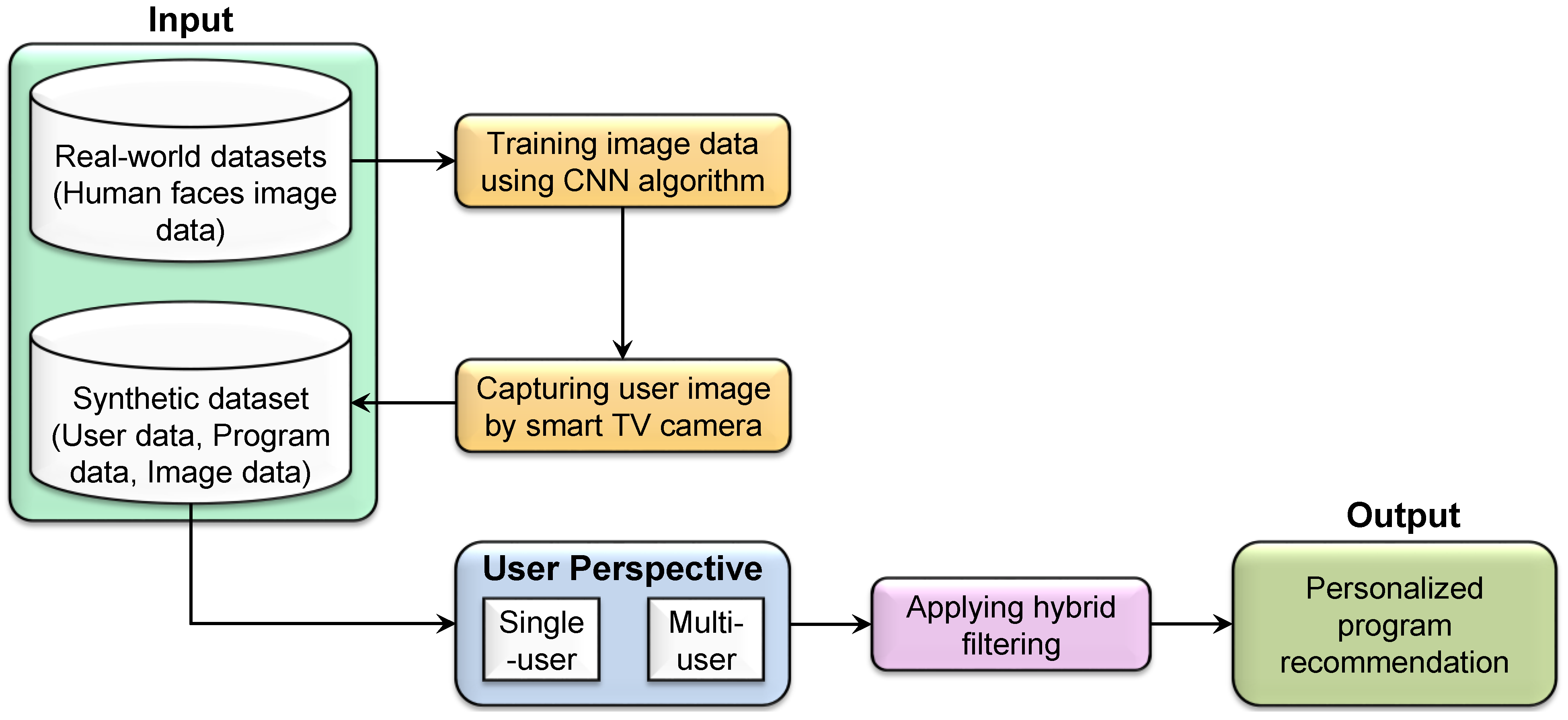
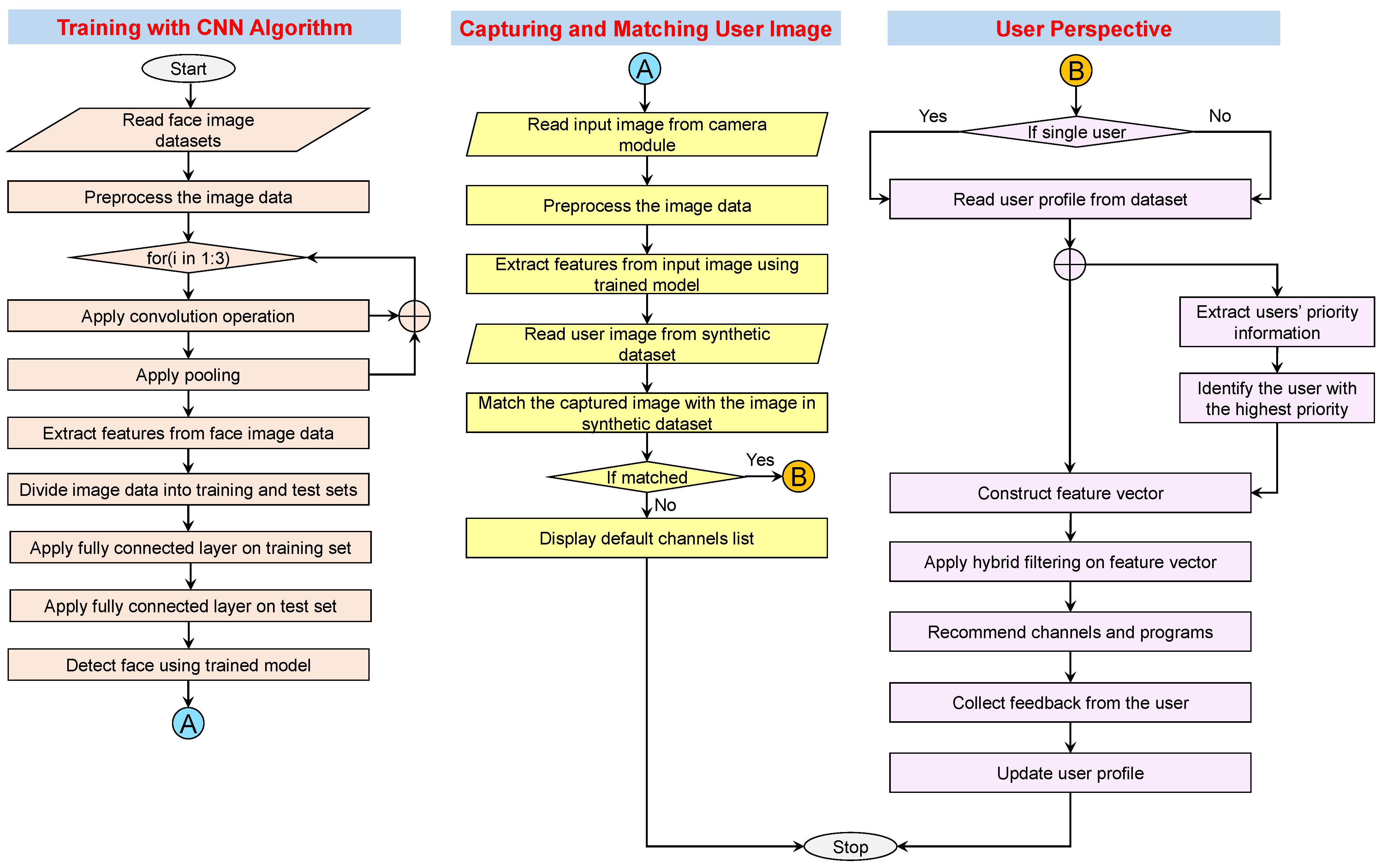


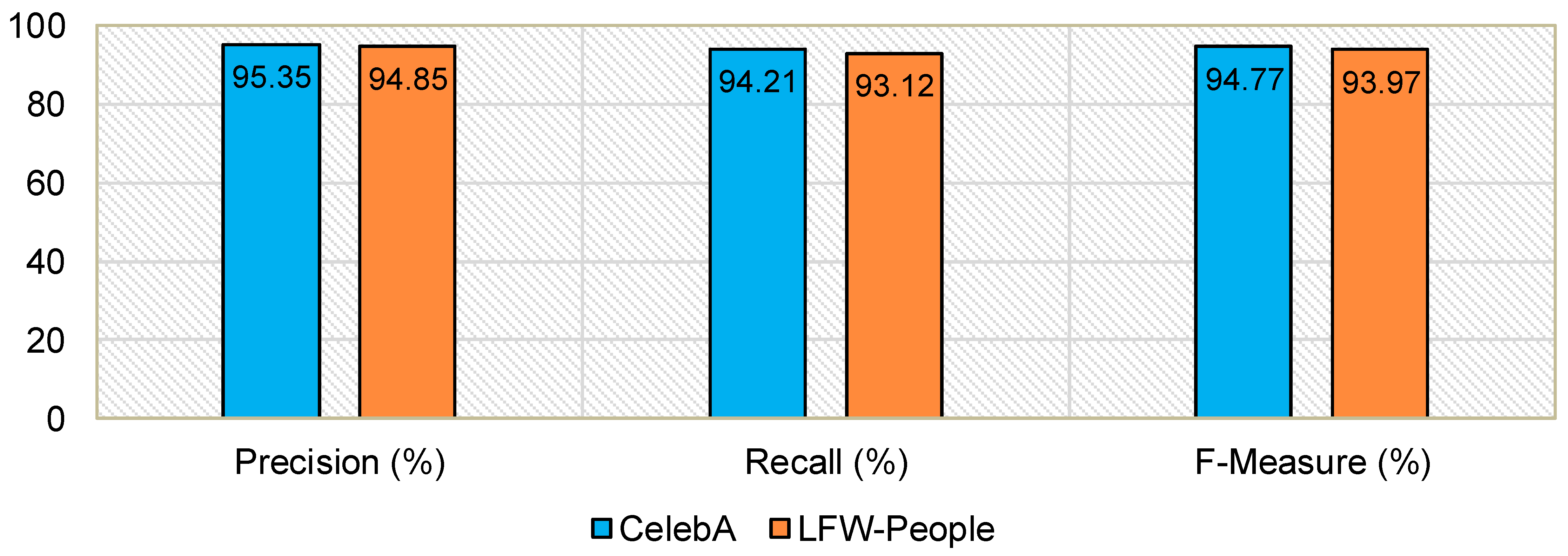
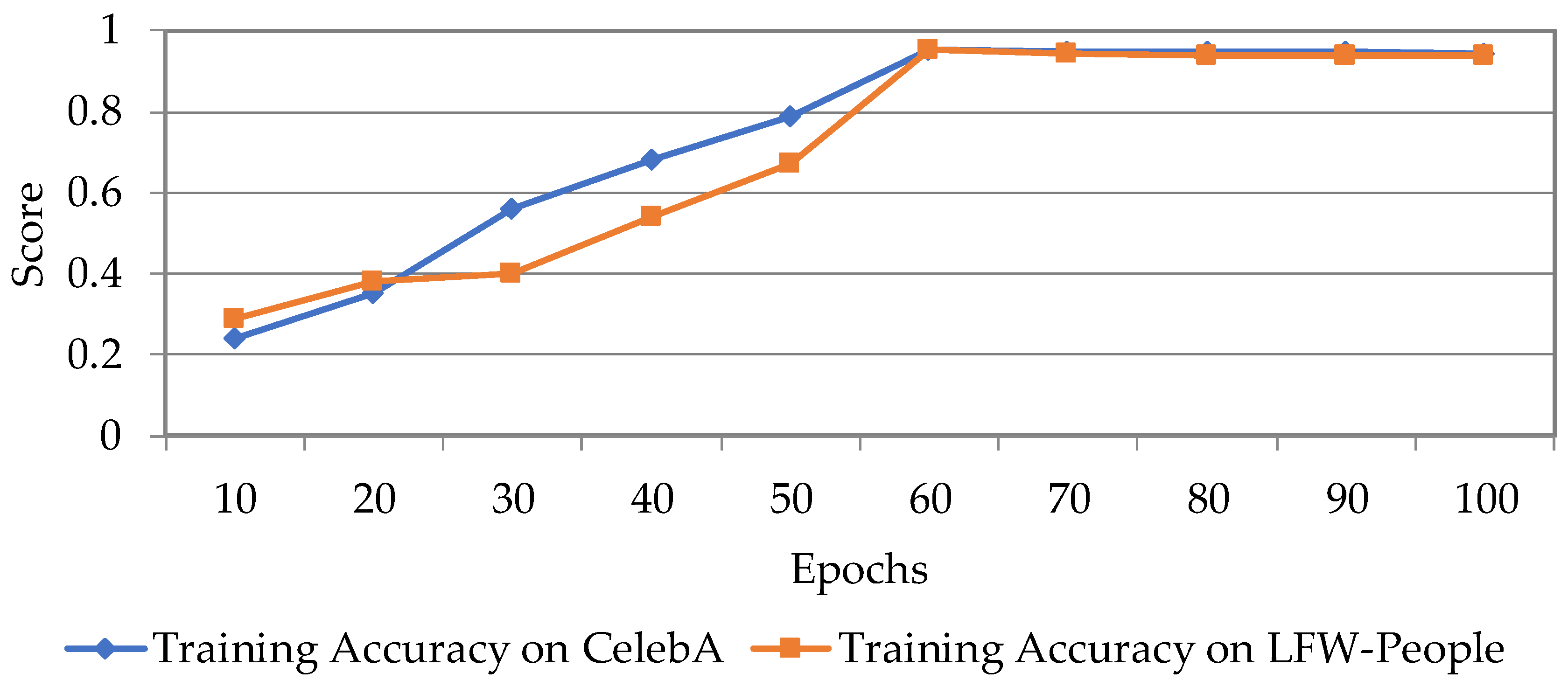

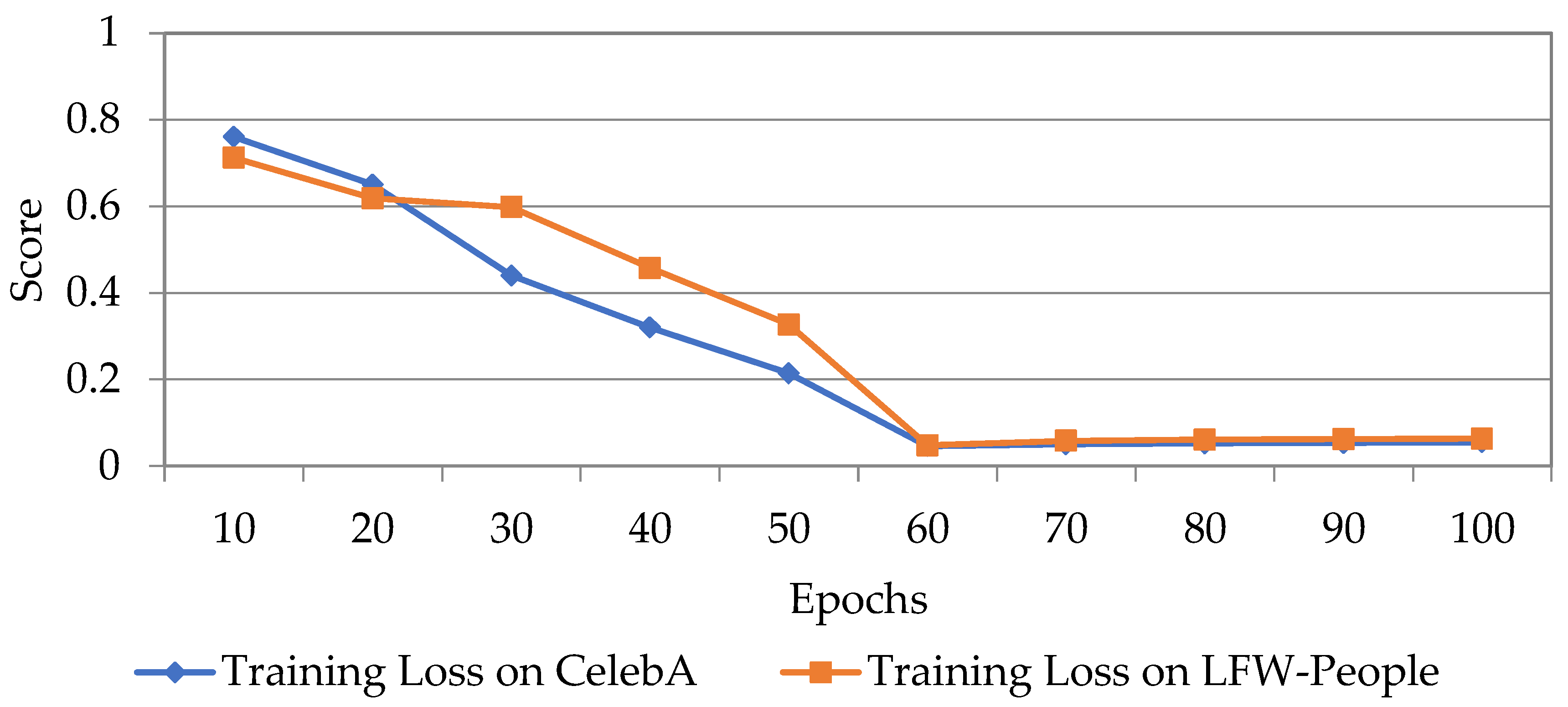

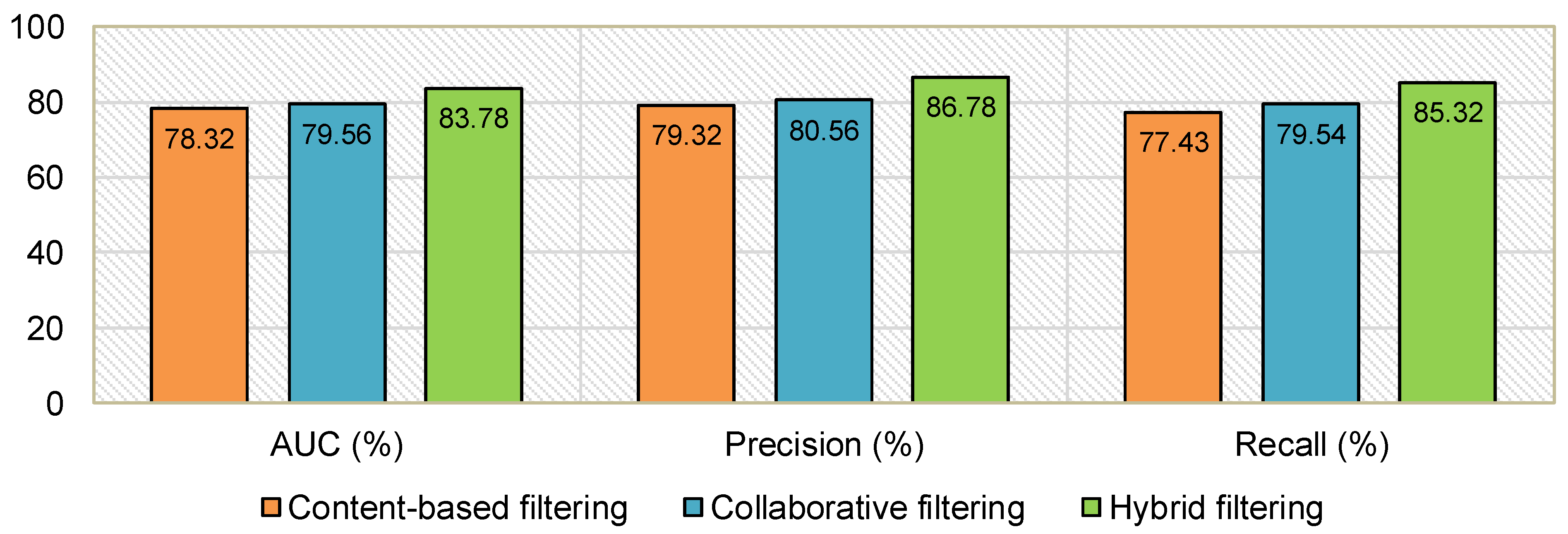
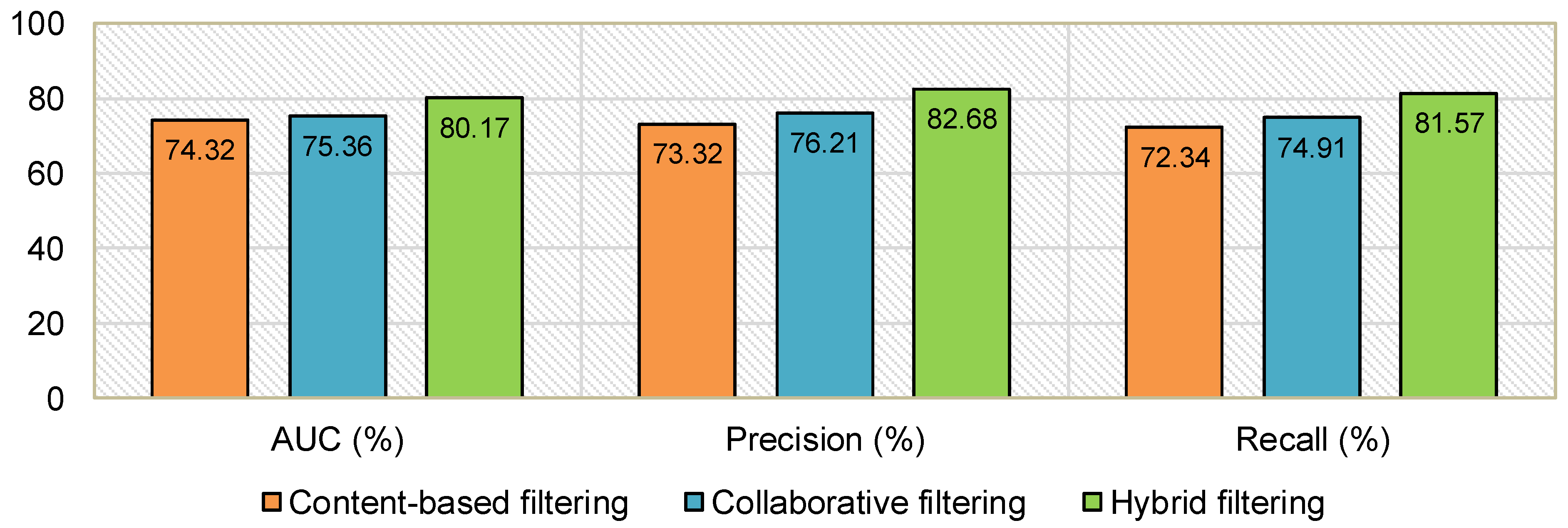
| Dataset | Dataset Size |
|---|---|
| CelebA | 202,599 images |
| LFW-People | 13,000 images |
| Total no. of images | 215,599 images |
| User ID | Channels List | Programs List | Duration on Each Channel | User Priority | Image |
|---|---|---|---|---|---|
| 1001 |
|
|
| 1 | User1.png |
| 1002 |
|
|
| 2 | User2.png |
| 1003 |
|
|
| 3 | User3.png |
| 1004 |
|
|
| 4 | User4.png |
| 1005 |
|
|
| 5 | User5.png |
| Channel ID | Channel Name | Program ID | Program Name |
|---|---|---|---|
| 5001 | Sonypix | 6001 | Cricket |
| 5002 | Star Movies | 6002 | Football |
| 5003 | Star Sports | 6003 | News |
| 5004 | India Today | 6004 | Action Movies |
| 5005 | Colors | 6005 | Reality Show |
| 5006 | Star Plus | 6006 | Action Movies |
| 5007 | Star World | 6007 | Dance Programs |
| 5008 | HBO | 6008 | Cookery Program |
| 5009 | Zee TV | 6009 | Reality Show |
| 5010 | Star Gold | 6010 | Cartoon |
| 5011 | Sony Max | 6011 | Fantasy Movies |
| 5012 | UTV Movies | 6012 | Drama |
| 5013 | Star Sports2 | 6013 | Chat Show |
| 5014 | Star Utsav | 6014 | Game Show |
| 5015 | Colors Infinity | 6015 | Football |
| 5016 | Zee Bollywood | 6016 | Cartoon |
| Layer Type | Filter/Size | Activation |
|---|---|---|
| Conv2D | 64 (4, 4) | ReLu |
| Maxpool | (4, 4) | Nil |
| Conv2D | 64 (3, 3) | ReLu |
| Conv2D | 64 (3, 3) | ReLu |
| Avgpool2D | (3, 3) | Nil |
| Conv2D | 128 (3, 3) | ReLu |
| Conv2D | 128 (3, 3) | ReLu |
| Avgpool2D | (3, 3) | Nil |
| Dense | 1024 | ReLu |
| Dropout | Nil | Rate = 0.28 |
| Dense | 1024 | ReLu |
| Dropout | Nil | Rate = 0.28 |
| Dense | 2 | Softmax |
| Hyperparameter | Value/Name |
|---|---|
| Epoch | 60 |
| Batch size | 60 |
| Loss function | Binary cross entropy |
| Optimizer | Adaptive moment estimation |
| Dataset | Precision (%) | Recall (%) | F-Measure (%) | Cohen Kappa Score (−1 to 1) |
|---|---|---|---|---|
| CelebA | 95.35 | 94.21 | 94.77 | 0.856 |
| LFW-People | 94.85 | 93.12 | 93.97 | 0.889 |
| User ID | Program Preferences | Recommended Programs | Matching Programs |
|---|---|---|---|
| 1001 | 4 | 12 | 10 |
| 1002 | 5 | 10 | 8 |
| 1003 | 5 | 11 | 7 |
| 1004 | 4 | 8 | 7 |
| 1005 | 6 | 13 | 11 |
| Method | AUC (%) | Precision (%) | Recall (%) |
|---|---|---|---|
| Content-based filtering | 78.32 | 79.32 | 77.43 |
| Collaborative filtering | 79.56 | 80.56 | 79.54 |
| Hybrid filtering | 83.78 | 86.78 | 85.32 |
| Group ID | Group Size | Common Program Preferences | Recommended Programs | Matching Programs |
|---|---|---|---|---|
| 2001 | 5 | 6 | 15 | 10 |
| 2002 | 4 | 8 | 13 | 9 |
| 2003 | 6 | 12 | 19 | 16 |
| 2004 | 3 | 10 | 11 | 10 |
| 2005 | 7 | 8 | 21 | 18 |
| Method | AUC (%) | Precision (%) | Recall (%) |
|---|---|---|---|
| Content-based filtering | 74.32 | 73.32 | 72.34 |
| Collaborative filtering | 75.36 | 76.21 | 74.91 |
| Hybrid filtering | 80.17 | 82.68 | 81.57 |
Disclaimer/Publisher’s Note: The statements, opinions and data contained in all publications are solely those of the individual author(s) and contributor(s) and not of MDPI and/or the editor(s). MDPI and/or the editor(s) disclaim responsibility for any injury to people or property resulting from any ideas, methods, instructions or products referred to in the content. |
© 2023 by the authors. Licensee MDPI, Basel, Switzerland. This article is an open access article distributed under the terms and conditions of the Creative Commons Attribution (CC BY) license (https://creativecommons.org/licenses/by/4.0/).
Share and Cite
Dudekula, K.V.; Syed, H.; Basha, M.I.M.; Swamykan, S.I.; Kasaraneni, P.P.; Kumar, Y.V.P.; Flah, A.; Azar, A.T. Convolutional Neural Network-Based Personalized Program Recommendation System for Smart Television Users. Sustainability 2023, 15, 2206. https://doi.org/10.3390/su15032206
Dudekula KV, Syed H, Basha MIM, Swamykan SI, Kasaraneni PP, Kumar YVP, Flah A, Azar AT. Convolutional Neural Network-Based Personalized Program Recommendation System for Smart Television Users. Sustainability. 2023; 15(3):2206. https://doi.org/10.3390/su15032206
Chicago/Turabian StyleDudekula, Khasim Vali, Hussain Syed, Mohamed Iqbal Mahaboob Basha, Sudhakar Ilango Swamykan, Purna Prakash Kasaraneni, Yellapragada Venkata Pavan Kumar, Aymen Flah, and Ahmad Taher Azar. 2023. "Convolutional Neural Network-Based Personalized Program Recommendation System for Smart Television Users" Sustainability 15, no. 3: 2206. https://doi.org/10.3390/su15032206
APA StyleDudekula, K. V., Syed, H., Basha, M. I. M., Swamykan, S. I., Kasaraneni, P. P., Kumar, Y. V. P., Flah, A., & Azar, A. T. (2023). Convolutional Neural Network-Based Personalized Program Recommendation System for Smart Television Users. Sustainability, 15(3), 2206. https://doi.org/10.3390/su15032206







